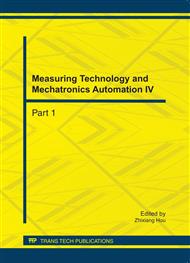p.1417
p.1421
p.1426
p.1430
p.1434
p.1438
p.1443
p.1448
p.1452
EEG Signal Classification by Global Field Power
Abstract:
Our project focuses on the emotional face evoked EEG signal recognition. Since EEG signals contain enough information to separate different emotional facial expressions. Thus we propose a new approach which is based on global field power on EEG signal classification. In order to perform this result, firstly, we gather a dataset with EEG signals. This is done by measuring EEG signals from people aged 20-30 that are stimulated by emotional facial expressions (Happy, Neutral, Sad). Secondly, the collected EEG signals are preprocessed through using noise reduction method. And then select features by principal component analysis (PCA) to filter out redundant information. Finally, using fisher classifier and a 10-fold cross validation method for training and testing, a good classification rate is achieved when combination local max global field power EEG signals. The rate is 90.49%.
Info:
Periodical:
Pages:
1434-1437
Citation:
Online since:
October 2011
Authors:
Price:
Сopyright:
© 2012 Trans Tech Publications Ltd. All Rights Reserved
Share:
Citation:


